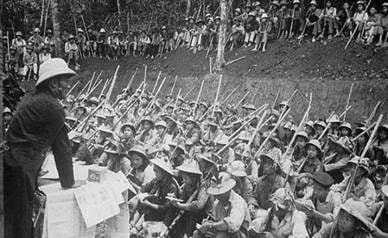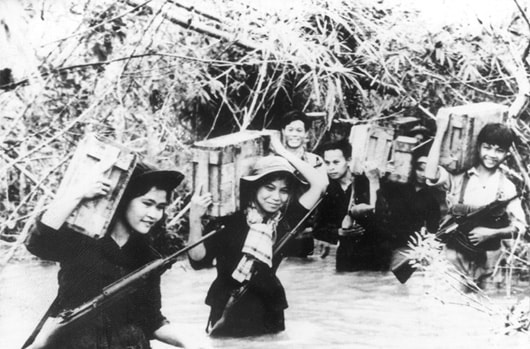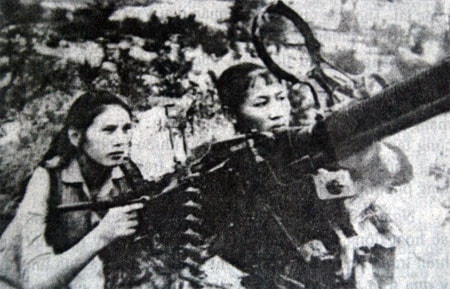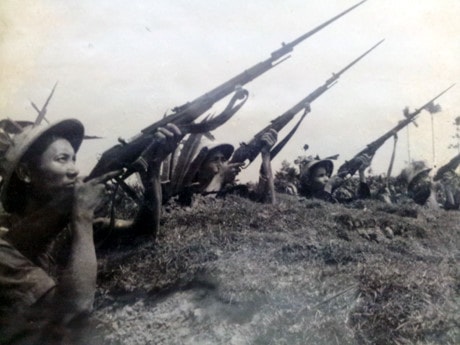The 'Iron Wall' of the Fatherland
(Baonghean.vn) - 82 years ago, on March 28, 1935, the 1st National Party Congress (held in Macau, China) passed the "Resolution on Self-Defense Forces". This was the first resolution of the Party on the organization, direction of building, training and operation of the Self-Defense Force. This day marked the birth and became the Traditional Day of the Vietnamese Militia and Self-Defense Force (DQTV). In 1949, President Ho Chi Minh signed a Decree to establish 3 types of troops including the main force, local troops and guerrillas.
From the "Red Self-Defense" teams - the predecessor of the Vietnamese revolutionary armed forces born in the Nghe Tinh Soviet movement (1930 - 1931) to the Bac Son Guerrilla Team, the National Salvation Army, the Ba To Guerrilla, the Southern Guerrilla Army, the guerrilla teams operating in war zones across the country... were all organized on the basis of the people's political forces under the leadership of the Party and served as the core for partial uprisings in localities, as the shock force in the General Uprising, smashing the French - Japanese domination, and taking the revolutionary government into the hands of workers and peasants (August 1945).
 |
| Militia and Self-Defense Forces in wartime. Photo courtesy |
During the resistance war against the French colonialists, with the policy of both resistance and nation building, a comprehensive, all-people resistance, our Party advocated promoting the development of the Militia and Self-Defense Forces, and guerrillas that were not separated from production, as the core force to fight the enemy locally.
President Ho Chi Minh once emphasized: "Those militia and guerrilla organizations can not only be responsible for suppressing counter-revolutionaries, maintaining security in villages and communes, protecting the interests of the masses, fighting the enemy and coordinating with the main force, but can also supplement the main force."
Thanks to that, the Militia and Guerrilla forces had a remarkable development from about one hundred thousand people in the August 1945 General Uprising to about one million people in early 1946, with a large scale throughout the country, forming a network spread across the mountains, forests, plains, and urban areas.
 |
| National Defense soldiers and people of Hanoi fought to defend every house and street corner in the early days of the nationwide resistance war. Photo courtesy |
Implementing the policy of "turning the enemy's rear into our front line", with rudimentary weapons in hand, the Militia and guerrillas relied on the terrain and topography of the villages, and on the people's war posture to destroy evil and eliminate traitors, contributing to building, expanding and protecting base areas; at the same time, coordinating with local troops to conduct guerrilla warfare, wearing down and destroying enemy forces, and trapping the enemy in urban areas, cities and towns.
In particular, in the final stage of the resistance war, especially the Winter-Spring of 1953-1954, the peak of which was the Dien Bien Phu Campaign, the activities of the Militia and Guerrillas coordinated well with the main force and local troops to attack strongly, contributing greatly to the victory that "resounded throughout the five continents and shook the earth", forcing France to sign the Geneva Agreement, ending the war and restoring peace in Indochina.
Entering the resistance war against the US to save the country, thoroughly grasping the Party's revolutionary policies and lines, the Militia and Self-Defense Forces and guerrillas of the North and South continued to make many contributions to the construction and protection of the socialist North, and carrying out the people's national democratic revolution in the South.
 |
| Militia forces carry ammunition to the battlefield. Photo: Archive |
During the years when the US imperialists escalated and expanded the war of destruction in the North (1965 - 1973), the Northern Militia and Self-Defense Force developed rapidly in both quantity and quality (accounting for 12% of the Northern population), was organized into platoons, companies, and in some places established battalions, regiments, and divisions; equipped with weapons suitable to the combat missions of each force.
In the Northern localities, in coordination with the People's Public Security Forces, many achievements were achieved, security and order were maintained. The Militia and Self-Defense Forces were also the core force and soul in production and combat movements: "Plowman in hand, gun in hand", "Hammer in hand, gun in hand", "Producing while fighting", "Singing drowns out the sound of bombs"...
 |
| Guerrillas and self-defense forces of Zone 5 in the resistance war against the US to save the country. Photo archive |
In addition, the Militia and Self-Defense Force is also an important "link" in the multi-layered, multi-directional three-army air defense network, contributing with the Northern army and people to defeat the destructive war by the US air force and navy, firmly protecting the great rear of the North, and effectively supporting the great front line of the South.
In the South, the armed self-defense and guerrilla teams appeared as the core to support the political struggle movement against the pacification policy of the US and the Ngo Dinh Diem government. By 1960, the Southern militia and guerrilla force had developed to about 10,000 people with self-defense and guerrilla teams in villages, communes and hamlets. Combining the Party's "two-legged", "three-pronged", "three-region" struggle motto, the army and people of the South stepped up guerrilla warfare.
 |
| Militiamen of Dien Hung commune, Dien Chau district (Nghe An) used infantry guns to shoot down an American jet plane. Photo: Archive |
The militia and guerrillas coordinated with local troops and main force troops to defeat the new war tactics of "Helicopter Transport" and "Armored Vehicle Transport", to gather people and establish strategic hamlets of the US and the Army of the Republic of Vietnam. When the US switched to the "Local War" strategy, to proactively prepare to deal with the new combat object, the revolutionary forces in the South, of which the core was the armed forces for the liberation of the South, of which the militia and guerrillas were an important component, developed rapidly.
Thoroughly implementing the motto "province liberates province, district liberates district, commune liberates commune", the Militia and Self-Defense Force and guerrillas are the core force in combat operations in villages and communes; protecting people and areas; at the same time, ready to supplement and strengthen the local army and main force, making an important contribution to the common victory of the army and people of the whole country in the Great Victory of Spring 1975, completely liberating the South and unifying the country.
 |
| Vietnam's Militia and Self-Defense Force is growing stronger and stronger - the "Iron Wall" in the cause of building and defending the Fatherland. |
With its enormous contributions to the cause of national liberation, construction and protection of the Fatherland over the past eight decades, the Militia and Self-Defense Force is worthy of President Ho Chi Minh's affirmation: "The Militia and Self-Defense Force and Guerrillas are the force of the entire nation, an invincible force, an iron wall of the Fatherland. No matter how ferocious the enemy is, if they come into contact with that force, that wall, any enemy will be destroyed."
In the "Strategy for protecting the Fatherland in the new situation", the Militia and Self-Defense Force is still considered the core force in building "the people's hearts and minds", building the all-people national defense, building defense zones and building fighting villages and communes in the current defense zones of the province, contributing with the army and people of the whole country to firmly protect the Socialist Republic of Vietnam.
Peace
(Synthetic)
| RELATED NEWS |
|---|

